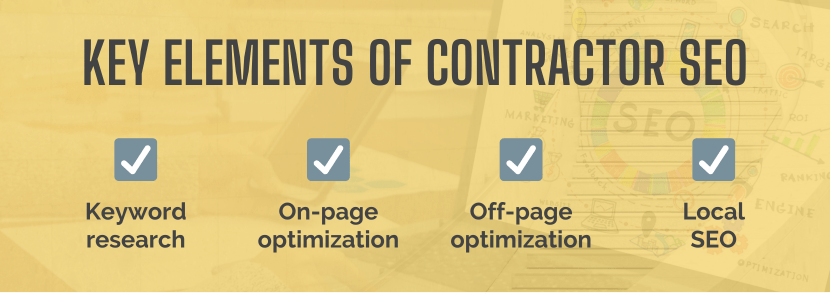So, let’s say you’re a construction company owner. You realize the importance of a website and have invested time and resources into building one that showcases your services. But here’s the catch: a website alone is like a billboard in the desert. It’s there, but who’s going to see it? That’s where contractor SEO, or Search Engine Optimization, comes into play.
Or let’s say you have an up-and-running website for your construction business, and you are yet to generate traffic, talk less of generating a worthy lead. You are not alone; studies show a staggering 9 out of every 10 web pages never receive a single visit from Google! It’s a common challenge, but it’s not insurmountable.
It’s not just enough to have a website. Just like it’s not good enough to build a storefront and expect people will simply stop by.
If your website doesn’t appear in those crucial search results, you’re essentially invisible to a vast portion of your market. It’s like having a state-of-the-art showroom with no roads leading to it. People may know it exists, but how will they find it?

SEO is the art and science of making your website attractive to search engines. It’s about understanding what your potential clients are looking for online and ensuring that your website is ready to meet them when they search. It’s about speaking the language of Google and Bing, all while delivering valuable content to your human visitors.
Mastering SEO can mean the difference between a steady stream of new projects and a phone that never rings. It can help you reach out to your local community, establish your reputation, and stand out in a crowded market of construction companies. In the following sections, we’ll delve into the key elements of contractor SEO, providing you with a roadmap to online visibility and business growth.
Key Takeaways
1. Master SEO: Understand and apply contractor SEO principles to make your construction business website attractive to search engines, enhancing visibility and connecting with potential clients.
2. Conduct keyword research: Utilize tools like Google Keyword Planner to discover the exact words and phrases your potential clients use, integrating them into your content to boost relevance and visibility.
3. Optimize on-page elements: Focus on title tags, meta descriptions, URL structure, internal linking, image optimization, and mobile-friendly design to create a seamless user experience and improve search engine ranking.
4. Invest in local SEO: Claim and optimize your Google Business Profile, maintain consistent NAP (Name, Address, Phone Number) information, and engage with local directories to enhance local search results.
5. Create engaging content: Develop a content strategy that includes multimedia elements, targeted keywords, and valuable information that resonates with your audience, enhancing engagement and shareability.
6. Monitor and analyze performance: Implement tools like Google Analytics to track keyword rankings, organic traffic, user behavior, and conversions, making data-driven optimizations for continuous improvement.
7. Optimize for voice search: Adapt content and keywords for voice queries, improve website accessibility, and monitor voice search performance to stay relevant in the emerging trend of voice-activated searches.
8. Stay ahead with SEO updates and trends: Regularly monitor algorithm updates, embrace emerging SEO trends, engage with industry communities, and invest in continuous learning to ensure your website remains competitive and aligned with best practices.
What is SEO and why does it matter?
SEO, or Search Engine Optimization, is akin to the compass that guides your business through the vast digital landscape. It’s a set of strategies and techniques designed to boost your website’s visibility on search engine results pages (SERPs). But what does this mean for you as a contractor?
Imagine a potential client is searching for the “best roofing contractor near me” on Google. With an effective construction company industry SEO campaign, your own construction company or business website could be the first one to appear in local search rankings they see in the search results. Visibility in search engines can lead to increased website traffic, more qualified leads, and, ultimately, more clients.
SEO for construction companies is more than being seen by anybody, though. It’s about being found by the right people – those who need your services and are ready to hire a contractor. It’s about connecting with your local community, building trust with potential clients, and establishing your business as an authority in the construction industry.
Key elements of contractor SEO
Just as a building requires a solid foundation, effective SEO for construction companies is built on several key elements. These elements work together, creating a comprehensive strategy that can help your construction business or your construction company website rise to the top of search engine results.

Keyword research
Think of keyword research as understanding the language of your potential clients. It’s about discovering the exact words and phrases they use when searching for your construction services. By integrating these keywords into your website content, you can speak directly to your audience and to search engines, enhancing your visibility.
On-page optimization
On-page optimization or on-site SEO is like the interior design of your website. SEO for construction companies involves optimizing elements such as title tags, meta descriptions, and content to make your website more attractive to search engines. It’s about ensuring that when search engines ‘read’ your site, they find relevant, high-quality content that deserves a top spot in the search results.
Off-page optimization
Off-page SEO is about building your website’s reputation. Just as a contractor construction business relies on word-of-mouth referrals, websites, and other search engines rely on links from other sites to boost their credibility. High-quality backlinks tell search engines that your site is a trusted authority, helping to improve your website traffic search rankings.
Local SEO
For contractors, local SEO is the cornerstone of online success. It’s about optimizing your online presence to attract business from local searches. After all, if you’re a contractor or construction company based in Boston, you want to be found by clients in Boston, not in Los Angeles. Local SEO helps you with local searches and reach the right people in the right places.
Comprehensive keyword research for construction companies
SEO Without a Keyword Strategy is Building Without a Blueprint.
A successful construction SEO strategy begins with effective keyword research. If you or your agency don’t have a keyword strategy, anything else you do in SEO is pretty much pointless.
Keywords are the words and phrases that people type into search engines when they’re looking for construction services like yours. By understanding and using these keywords in your content, you can increase your business account visibility in search engine results and attract more potential clients.
Importance of targeted keywords
Targeted keywords are like the beacon that attracts your ideal clients. They are the words and phrases that your potential clients are most likely to use when they’re ready to hire a contractor.

Targeted keywords are crucial for SEO because they help you attract the right audience and more leads. By using keywords that are relevant to the construction business, your services, and your target market, you can increase search visibility and your chances of appearing in search results for people who are likely to become clients.
Tools and techniques for effective keyword research
Effective keyword research is a blend of art and science, and there are many tools and techniques that can help. Keyword research tools like Google Keyword Planner and SEMRush can provide valuable insights into keyword popularity, competition, and relevance. Techniques like competitor analysis and long-tail keyword research can help you uncover valuable keywords that might otherwise be overlooked.
Identifying high-intent keywords for contractors
High-intent keywords indicate a readiness to purchase or hire. For contractors, these might include phrases like “construction companies for homes” or “best roofing contractor in Nashville.”
Identifying and targeting these high-intent keywords can help you attract more customers who are ready to hire a contractor for free service.
Long-tail keyword optimization
Long-tail keywords are the less obvious, often highly valuable phrases that potential clients might use. These longer, more specific phrases often indicate a clear understanding of what the user is looking for, making them particularly valuable for contractors. By identifying and optimizing for these long-tail keywords, you can connect with clients who are looking for the exact services you offer.
Think of it like bidding for projects. Do you want to bid on 1 big project that 50 other construction companies have already bid for or 5 small to medium projects that only 1-3 businesses have bid for? Which one will bring more revenue to your contractor business?
Optimizing on-page elements
Imagine you’re building a house. You wouldn’t start without a solid foundation, right? The same goes for your website.
On-page SEO optimization is the foundation
SEO must be infused into every part of your website to do its job effectively – from the words and images visitors see to the behind-the-scenes code. The objective of on-page SEO is to make sure your website is built so that search engines like Google can easily understand and customers can effortlessly navigate. Let’s break down what that looks like.
Title tags and meta descriptions
Think of title tags and meta descriptions as your online business card. They’re the first thing people see when your website pops up in search results.
Your title tag is like the name of your business – it should be clear, catchy, and tell people exactly what you do. And just like you’d want your business name to include ‘contractor’ or your specialty, you want your title tag to include the keywords your customers are searching for.
Meta descriptions are like your elevator pitch. They give people a quick snapshot of what you do and why they should choose you. While they don’t directly affect your search ranking, a good meta description is an SEO process that can make people more likely to click on your site.
Header tags and content optimization
Header tags (H1, H2, H3, etc.) and content optimization are about making your website easy to read and understand. Header tags and page titles are like the chapter titles in a book – they help guide readers through your page and let search engines know what your content is about.
The content should be useful, engaging, and include the relevant keywords your customers are searching a particular page for. It’s about striking a balance between writing for your customers and search engines – your content should provide value to your customers while also signaling to search engines what your page is about.
URL structure and internal linking
The URL structure of your web pages and the internal links connecting them are like signposts on a road. They guide your customers and search engines through your site, generating links and helping them understand how your pages relate to each other.
A good URL is like a good street address on Google Maps – it’s clear, easy to understand, and gives an idea of what you’ll find when you get there. Internal links on web pages are like the roads connecting different addresses – they help your customers navigate your site and find related information.
Image optimization and alt tags
There’s a saying, “A picture is worth a thousand words.” On your website, images can convey information quickly, break up text, and make your site more engaging. But just like you wouldn’t use a sledgehammer for a finishing nail, it’s important to use images wisely on your website. That’s where image optimization and alt tags come in.
Image optimization is about making sure your images load quickly without losing quality. Think of it like loading your work truck. You want to pack in everything you need, but overloading it can slow you down. Large, high-resolution images can slow your website loading time, which can frustrate potential customers and hurt your search engine rankings. You can keep your site running smoothly by resizing images and using the right file formats.
Alt tags, on the other hand, are like labels on your tools. These tags seve as an on-site SEO package that tells search crawlers what your images are about. This is important because search engines can’t ‘see’ images the way we do – they rely on alt tags to understand the image content. Alt tags also help people who use screen readers because of visual impairments.
Building a solid website structure
 Think of your construction website as a house you’re building for your customers. Just as a house needs a solid structure to keep it standing, your website needs a strong, logical structure to make it user-friendly and search engine-friendly. This involves creating clear categories, logical navigation, and a layout that makes sense. It’s about ensuring that every room (or page) has a clear purpose and that it’s easy for your customers (and search engines) to move from one room to another.
Think of your construction website as a house you’re building for your customers. Just as a house needs a solid structure to keep it standing, your website needs a strong, logical structure to make it user-friendly and search engine-friendly. This involves creating clear categories, logical navigation, and a layout that makes sense. It’s about ensuring that every room (or page) has a clear purpose and that it’s easy for your customers (and search engines) to move from one room to another.
Mobile-friendly design and responsiveness
In today’s digital world, many of your customers are likely to first encounter your business on their mobile devices. Just as you’d ensure a house is accessible for all visitors, your website needs to be accessible and user-friendly, regardless of the device used to view it. A mobile-friendly design ensures your website looks good and functions well, whether it’s being viewed on a desktop computer, a smartphone, or a tablet. And just as importantly, search engines favor websites that are mobile-friendly.
User-friendly navigation and site architecture
User-friendly navigation is like the clear, well-placed signs in a building that guide visitors to their destination. Your website should be easy to navigate, with clear menus, logical page hierarchy, and internal links that guide visitors from one page to another. The easier it is for people to find what they’re looking for on your site, the more likely they are to stick around and become customers.
Site speed optimization
Nobody likes to wait – whether it’s for a page to load or a contractor to show up. Site speed optimization is about making sure your website loads quickly so your customers aren’t left waiting. This involves optimizing your images, minimizing your code, and using website caching, among other strategies. A faster website can lead to happier customers, lower bounce rates, and better search engine rankings.
Creating compelling and informative landing pages
Your landing pages are like your sales pitch. They’re where you convince your visitors to become customers. A good landing page is clear, compelling, and focused on a single goal – whether that’s getting a quote, booking a job, or just learning more about your services. It should provide all the information your customers need to make a decision without overwhelming them with too much detail. Plus, landing pages optimized with your target keywords can help boost your business page and visibility in search engine results.
Local SEO for contractors
Local SEO is like your local reputation – it’s all about making sure the people in your area know who you are and what you do. As a contractor, construction company, or business, your company is literally helping to build up your local community. Local SEO helps you reach the people who are most likely to use your services – the people in your area.
Claiming and optimizing Google Business Profile listing
Your Google Business Profile is like your online storefront. It’s often the first thing people see when they search for your business, and it gives them key information like your hours, location, and services. Claiming and optimizing your Google Business Profile listing ensures that this information is accurate, complete, and appealing to potential customers.
NAP (Name, Address, Phone Number) consistency
Just like you’d want your business name and contact information to be consistent on your business cards and signage, you want it to be consistent online. This includes your website, your Google Business Profile, and any other places your business is listed online. Consistent NAP information helps search engines understand your business and can improve your visibility in local search results.
Local directory listings and citations
Being listed in local directories is like being part of a local business association. It helps establish your business as a part of the local community and boost your visibility in local search results. Plus, each listing is a citation – mentioning your business name and contact information – which can help improve your local business listings, search rankings, and SEO.
Soliciting customer reviews and ratings
Customer reviews are like word-of-mouth referrals. They can help build trust with potential customers online and influence their decision to hire you. Plus, search engines take reviews into account when ranking local businesses in local search results. Encouraging happy customers to leave reviews can boost your online reputation and your local SEO.
Generating high-quality backlinks
Backlinks are like recommendations in the digital world. They’re links from other websites to your own, and they can play a big role in your SEO. Just like a good recommendation can boost your reputation, a high-quality backlink can boost your visibility on search engines.
Importance of backlinks for SEO
Backlinks are important for SEO because they signal to search engines that your website is a trusted resource. It’s like getting a thumbs-up from other businesses in your industry.. When a reputable website links to your site, search engines see that as a vote of confidence, which can boost your ranking in search results.
Strategies for acquiring authoritative backlinks

Getting authoritative backlinks is like networking with the big players in your industry. It involves reaching out to reputable websites and blogs in your field and finding ways to get them to link to your site. This could involve creating valuable content that they want to share, collaborating on a project, or simply building a partnership.
Guest blogging and content collaborations
Guest blogging and content collaborations are like being a guest speaker at a conference. They allow you to share your expertise with a wider audience and can be a great way to earn backlinks. By providing valuable content for other websites in your industry, you can reach their audience and earn a link back to your blog post or site.
Social media promotion and influencer outreach
Social media promotion and influencer outreach are like hosting a local event or workshop. They allow you to engage with your audience, build relationships, and increase your visibility. While social media links don’t directly impact SEO, they can help increase your social signals, drive more traffic to your site, and lead to more traffic.
Influencer outreach involves connecting with influential figures in your industry who can share your content with their followers.
If there aren’t a lot of influencers in your construction niche, it might be time to consider building some content yourself. Over time, construction companies will be reaching out to you for partnerships.
Creating engaging content
Creating engaging content is like building a showcase project. It’s about using your expertise and craftsmanship to create something that grabs attention and stands out from the crowd. In the digital marketing world, that means creating content that’s interesting, valuable, and relevant to your audience.
Types of content that resonates with contractor audiences
Just as different building materials are suited to different types of projects, different types of content resonate with different audiences and construction companies. For contractor audiences, this might include how-to guides, practical tips, project showcases, industry news, and the construction company’s website updates. The key is understanding what your audience finds valuable and interesting and creating content that delivers that value.
Developing a content strategy and editorial calendar
A content strategy is like a construction plan – it outlines what you’re going to build, how you’re going to build it, and when it needs to be done. An editorial calendar is a tool that helps you execute that plan. It helps you plan out your content in advance, keep track of what you’re publishing and when, and ensure that you’re consistently delivering valuable content to your audience.
Incorporating targeted keywords into content
Incorporating targeted keywords in your content is like using the right tools for the job. It helps ensure that your content is relevant to what your audience is searching for and that search engines can understand what your content is about. By naturally incorporating targeted keywords into your content, you can make your content more discoverable by organic search and attract more of the right kind of traffic to your site.
Utilizing multimedia elements to enhance engagement
Utilizing multimedia elements, like images, videos, and interactive content, can enhance engagement like a well-designed space can draw people in. These elements can make your content more engaging, memorable, and likely to be shared. They can also help break up text and make your content easier to digest. Like in your contracting work, it’s all about creating an experience your audience will enjoy and remember.
Monitoring and analyzing performance
 Monitoring and analyzing your performance is a crucial part of SEO. By tracking your keyword rankings, organic traffic, and user behavior, you and your sales team can gain valuable insights that can help you improve your SEO strategy.
Monitoring and analyzing your performance is a crucial part of SEO. By tracking your keyword rankings, organic traffic, and user behavior, you and your sales team can gain valuable insights that can help you improve your SEO strategy.
Implementing website analytics tools
Website analytics tools, like Google Analytics, can provide a wealth of information about your website and your visitors. This includes data on how people find your site, which pages they visit, how long they stay, and what actions they take. By analyzing this data, you can identify what’s working, what’s not, and where there are opportunities for improvement.
Tracking keyword rankings and organic traffic
Tracking your keyword rankings and organic traffic can help you understand how well your SEO and content marketing efforts are working. If your rankings and traffic are increasing, that’s a good sign that your SEO strategy is effective. If not, it may be time to revisit your keywords or your whole content marketing strategy.
Analyzing user behavior and conversions
Analyzing user behavior and conversions can provide valuable insights into how visitors interact with your site and what actions they take. This includes data on things like bounce rate (the percentage of visitors who leave your site after viewing only one page), conversion rate (the percentage of visitors who take a desired action, like filling out a contact form or requesting a quote), and user flow (the path that users take through your site).
Making data-driven optimizations based on insights
The data you gather from your analytics tools can provide valuable insights that can inform your SEO strategy. For example, if you find that certain keywords are driving a lot of traffic to your site, you might decide to create more content around those keywords. Or, if you find that certain pages have a high bounce rate, you might decide to improve the content or the user experience on those pages.
Optimizing for voice search
With the rise of voice-activated devices like Google Home and Amazon Echo, voice search is becoming increasingly important. Optimizing for voice search involves adapting your content and keywords to match the way people speak rather than the way they type.
The rise of voice search and its impact on Seo
Voice search is changing the way people find information through online searches. Instead of typing a query into a search engine, people can now simply ask a question out loud. This has implications for SEO, as voice searches tend to be more conversational and often include question phrases.
Adapting content and keywords for voice queries
To optimize for voice search, you need to adapt your content and keywords to match the way people speak. This often involves targeting long-tail keywords and question phrases and providing clear, concise answers to common questions.
Improving website accessibility for voice search
Improving your website’s accessibility can also help you optimize for voice search. This includes making sure your site is mobile-friendly (as many voice searches are done on mobile devices), using structured data (which can help search engines understand your content), and ensuring your site loads quickly.
Monitoring and optimizing voice search performance
Just like with traditional SEO, it’s essential to monitor your performance and make ongoing optimizations. This might involve tracking the performance of your voice-optimized content, analyzing the types of queries driving voice traffic to your site, and making adjustments based on your findings.
Staying ahead with SEO updates and trends
In the ever-evolving landscape of SEO, staying updated with the latest trends and algorithm changes for mobile search is crucial. It’s not just about optimizing your website; it’s about ensuring the technical aspects of your digital presence align with the current best practices and the expectations of search engines.
Keeping up with algorithm updates
Search engines, notably Google, frequently update their algorithms to improve the quality of search results. These updates can affect how websites are ranked in organic search results. Staying informed about these changes allows you to adjust your SEO strategy accordingly, ensuring your website remains competitive in search rankings.
Embracing emerging SEO trends for contractors
SEO trends evolve as user behaviors, technology, and search engine algorithms change. Embracing these trends, from voice search to mobile-first indexing, can give your business a competitive edge. By staying ahead of these trends, you can adapt your SEO strategy and ensure your website remains relevant and easily discoverable by potential clients.
Continuous learning and professional development
SEO is a dynamic field. As such, continuous learning and professional development are key to staying competitive. This involves staying updated on the latest SEO news, learning new skills, and refining your existing strategies. By investing in professional development, you can ensure your SEO knowledge stays current, and your website’s performance continues to improve.
Engaging with industry communities and resources
Engaging with SEO communities and resources can provide valuable insights and keep you informed about the latest developments in the field. This could involve participating in SEO forums, attending webinars, or following influential SEO experts on social media. By actively engaging with these resources, you can stay at the forefront of SEO trends and best practices, ensuring your website performs optimally.
Want help with your contractor SEO?
 Successful contractor SEO involves a combination of SEO strategies to rank higher. This could involve using keyword research tools, comprehensive keyword research, on-page and off-page optimization, local keywords, SEO with local search intent, content creation, and performance monitoring. Each of these elements plays a crucial role in enhancing your website’s visibility, driving organic traffic, and ultimately, attracting more valuable traffic and clients.
Successful contractor SEO involves a combination of SEO strategies to rank higher. This could involve using keyword research tools, comprehensive keyword research, on-page and off-page optimization, local keywords, SEO with local search intent, content creation, and performance monitoring. Each of these elements plays a crucial role in enhancing your website’s visibility, driving organic traffic, and ultimately, attracting more valuable traffic and clients.
However, it’s important to remember that for construction companies’ SEO is not a one-time task but an ongoing process. As search engine algorithms and user behaviors evolve, so should your SEO strategies.
Take the Stairs is a digital marketing agency that helps small construction companies compete in the marketplace with SEO and many other online marketing strategies.
We are a construction SEO company that understands the importance of ongoing optimization and adaptation. We’re committed to helping you stay ahead of the curve, ensuring your website performs at its best, and your construction company continues growing.
Contact us today to learn how we can help with your contractor SEO needs.






